Simulating Historical Earthquakes in Existing Cities for Fostering Design of Resilient and Sustainable Communities: The Ljubljana Case
Abstract
:1. Introduction
2. Seismic Risk in Slovenia from the Perspective of the National Disaster Risk Assessment
2.1. The National Disaster Risk Assessment Methodology
2.2. The Assessment of Seismic Risk
3. Building Stock and Seismic Hazard in Slovenia
3.1. The Building Stock in the Republic of Slovenia
3.2. The Seismic Hazard in Slovenia
4. Scenario-Based Seismic Risk Assessment Methodology
4.1. The Ground-Motion Model
4.2. The Damage Model
4.3. The Consequence Model
5. Consequences of the 1895 Ljubljana Earthquake on the Current Building Stock
5.1. Simulation of Ground-Motion Fields in Terms of PGA
5.2. Simulation of Building Stock Damage and Consequences
6. Discussion and Conclusions
Author Contributions
Funding
Institutional Review Board Statement
Informed Consent Statement
Data Availability Statement
Conflicts of Interest
References
- Chester, D.K. The 1755 Lisbon earthquake. Prog. Phys. Geogr. 2001, 25, 363–383. [Google Scholar] [CrossRef]
- Vidrih, R.; Godec, M. Ljubljanski potres leta 1895 in njegov vpliv na razvoj gradbeno-tehničnih predpisov. UJMA 1995, 231–237. Available online: http://www.sos112.si/slo/tdocs/ujma/1995/231_237.pdf (accessed on 21 May 2021).
- Santini, A.; Moraci, N. Seismic Engineering Conference: Commemorating the 1908 Messina and Reggio Calabria Earthquake (AIP Conference Proceedings 1020); American Institute of Physics: Melville, NY, USA, 2008; p. 2032. [Google Scholar]
- Di Ludovico, M.; Prota, A.; Moroni, C.; Manfredi, G.; Dolce, M. Reconstruction process of damaged residential buildings outside historical centres after the L’Aquila earthquake: Part II—“Heavy damage” reconstruction. Bull. Earthq. Eng. 2017, 15, 693–729. [Google Scholar] [CrossRef]
- Atalić, J.; Uroš, M.; Šavor, M.; Marija, N.; Miroslav, D. The Mw5.4 Zagreb (Croatia) earthquake of March 22, 2020: Impacts and response. Bull. Earthq. Eng. 2021. [Google Scholar] [CrossRef]
- Starbuck, W.H. Perspective—Cognitive Reactions to Rare Events: Perceptions, Uncertainty, and Learning. Organ. Sci. 2009, 20, 925–937. [Google Scholar] [CrossRef]
- Silva, V.; Crowley, H.; Pagani, M.; Monelli, D.; Pinho, R. Development of the OpenQuake engine, the Global Earthquake Model’s open-source software for seismic risk assessment. Nat. Hazards 2014, 72, 1409–1427. [Google Scholar] [CrossRef]
- Kohrangi, M.; Bazzurro, P.; Vamvatsikos, D. Seismic risk and loss estimation for the building stock in Isfahan: Part II—Hazard analysis and risk assessment. Bull. Earthq. Eng. 2021, 19, 1739–1763. [Google Scholar] [CrossRef]
- HAZUS MH 2.1. Technical Manual, Multi-Hazard Loss Assessment Methodology; Federal Emergency Management Agency: Washington, DC, USA, 2015.
- Farahani, S.; Behnam, B.; Tahershamsi, A. Macrozonation of seismic transient and permanent ground deformation of Iran. Nat. Hazards Earth Syst. Sci. 2020, 20, 2889–2903. [Google Scholar] [CrossRef]
- Farahani, S.; Tahershamsi, A.; Behnam, B. Earthquake and post-earthquake vulnerability assessment of urban gas pipelines network. Nat. Hazards 2020, 101, 327–347. [Google Scholar] [CrossRef]
- Felsenstein, D.; Elbaum, E.; Levi, T.; Calvo, R. Post-processing HAZUS earthquake damage and loss assessments for individual buildings. Nat. Hazards 2021, 105, 21–45. [Google Scholar] [CrossRef]
- Satish, D.; Prakash, E.L.; Anand, K.B. Earthquake vulnerability of city regions based on building typology: Rapid assessment survey. Asian J. Civ. Eng. 2021, 22, 677–687. [Google Scholar] [CrossRef]
- Pavel, F.; Vacareanu, R. Scenario-based earthquake risk assessment for Bucharest, Romania. Int. J. Disaster Risk Reduct. 2016, 20, 138–144. [Google Scholar] [CrossRef]
- Strasser, F.O.; Bommer, J.J.; Şeşetyan, K.; Erdik, M.; Çaǧnan, Z.; Irizarry, J.; Goula, X.; Lucantoni, A.; Sabetta, F.; Bal, I.E.; et al. A comparative study of European earthquake loss estimation tools for a scenario in Istanbul. J. Earthq. Eng. 2008, 12, 246–256. [Google Scholar] [CrossRef]
- Pitilakis, K.; Argyroudis, S.; Fotopoulou, S.; Karafagka, S.; Kakderi, K.; Selva, J. Application of stress test concepts for port infrastructures against natural hazards. The case of Thessaloniki port in Greece. Reliab. Eng. Syst. Saf. 2019, 184, 240–257. [Google Scholar] [CrossRef]
- Esposito, S.; Stojadinovic, B.; Babič, A.; Dolšek, M.; Iqbal, S.; Selva, J.; Broccardo, M.; Mignan, A.; Giardini, D. Risk-Based Multilevel Methodology to Stress Test Critical Infrastructure Systems. J. Infrastruct. Syst. 2020, 26, 04019035. [Google Scholar] [CrossRef]
- ICPD, Presidency of the Council of Ministers Italian Civil Protection Department. National Risk Assessment. Overview of the Potential Major Disasters in Italy: Seismic, Volcanic, Tsunami, Hydro-Geological/hydraulic and Extreme Weather, Droughts and Forest Fire Risks; ICPD: Rome, Italy, 2018. [Google Scholar]
- Dolšek, M.; Žižmond, J.; Babič, A.; Lazar Sinković, N.; Jamšek, A.; Gams, M.; Isaković, T. Seismic Stress Test of Building Stock in the Republic of Slovenia (2020–2050); University of Ljubljana, Faculty of Civil and Geodetic Engineering, Institute of Structural Engineering, Earthquake Engineering and Construction IT: Ljubljana, Slovenija, 2020. (In Slovenian) [Google Scholar]
- Official Gazette of the Republic of Slovenia, No 13/17. Decree Amending the Decree implementing the Decision on the Union Civil Protection Mechanism; The Government of the Republic of Slovenia: Ljubljana, Slovenia.
- Official Gazette of the Republic of Slovenia, No 62/14. Decree Implementing the Decision on the Union Civil Protection Mechanism; The Government of the Republic of Slovenia: Ljubljana, Slovenia.
- Government of the Republic of Slovenia, (GRS). National Disaster Risk Assessment, Version 2.0; The Government of the Republic of Slovenia: Ljubljana, Slovenia, 2018. (In Slovenian)
- Government of the Republic of Slovenia, (GRS). National Disaster Risk Assessment, Version 1.0; The Government of the Republic of Slovenia: Ljubljana, Slovenia, 2015. (In Slovenian)
- Lutman, M.; Klemenc, I.; Weiss, P.; Zupančič, P.; Šket Motnikar, B.; Banovec, P.; Cerk, M. POTROG—Seismic Risk in Slovenia for Civil Protection; Slovenian National Building And Civil Engineering Institute: Ljubljana, Slovenia, 2013. [Google Scholar]
- Grünthal, G. European Macroseismic Scale 1998; Centre Europèen de Géodynamique et de Séismologie, Musée National d’Histoire Naturelle, Section Astrophysique et Géophysique: Luxembourg, 1998. [Google Scholar]
- Government of the Republic of Slovenia, Surveying and Mapping Authority of the Republic of Slovenia. Real Estate Register. Available online: https://eprostor.gov.si/imps/srv/api/records/26252870-5100-4408-a3e0-54ea80eb3612 (accessed on 21 May 2021).
- Government of the Republic of Slovenia, Ministry of the Interior. Central Population Register. Available online: https://nio.gov.si/nio/asset/nio+centralni+register+prebivalstva+crp+vpogled+preko+emso?lang=en (accessed on 21 May 2021).
- Jiménez, B.; Pelà, L.; Hurtado, M. Building survey forms for heterogeneous urban areas in seismically hazardous zones. Application to the historical center of Valparaíso, Chile. Int. J. Archit. Herit. 2018, 12, 1076–1111. [Google Scholar] [CrossRef]
- Rapone, D.; Brando, G.; Spacone, E.; De Matteis, G. Seismic vulnerability assessment of historic centers: Description of a predictive method and application to the case study of scanno (Abruzzi, Italy). Int. J. Archit. Herit. 2018, 12, 1171–1195. [Google Scholar] [CrossRef]
- da Porto, F.; Donà, M.; Rosti, A.; Rota, M.; Lagomarsino, S.; Cattari, S.; Borzi, B.; Onida, M.; De Gregorio, D.; Perelli, F.L.; et al. Comparative analysis of the fragility curves for Italian residential masonry and RC buildings. Bull. Earthq. Eng. 2021, 19, 3209–3252. [Google Scholar] [CrossRef]
- Kohrangi, M.; Bazzurro, P.; Vamvatsikos, D. Seismic risk and loss estimation for the building stock in Isfahan. Part I: Exposure and vulnerability. Bull. Earthq. Eng. 2021, 19, 1709–1737. [Google Scholar] [CrossRef]
- Ruggieri, S.; Porco, F.; Uva, G.; Vamvatsikos, D. Two frugal options to assess class fragility and seismic safety for low-rise reinforced concrete school buildings in Southern Italy. Bull. Earthq. Eng. 2021, 19, 1415–1439. [Google Scholar] [CrossRef]
- Rota, M.; Penna, A.; Strobbia, C.L. Processing Italian damage data to derive typological fragility curves. Soil Dyn. Earthq. Eng. 2008, 28, 933–947. [Google Scholar] [CrossRef]
- Fajfar, P. Analysis in seismic provisions for buildings: Past, present and future. Bull. Earthq. Eng. 2018, 16, 2567–2608. [Google Scholar] [CrossRef] [Green Version]
- Kappos, A.J.; Panagopoulos, G.; Panagiotopoulos, C.; Penelis, G. A hybrid method for the vulnerability assessment of R/C and URM buildings. Bull. Earthq. Eng. 2006, 4, 391–413. [Google Scholar] [CrossRef]
- Pitilakis, K.; Argyroudis, S.; Kakderi, K.; Argyroudi, A. SYNER-G Project: Deliverable D8.20: Systemic Seismic Vulnerability and Risk Analysis for Buildings, Lifeline Networks and Infrastructures Safety Gain; Aristotle University of Thessaloniki & Commission of the European Communities—Directorate General Joint Research Centre: Ispra, Italy, 2013. [Google Scholar]
- Lapajne, J.; Šket Motnikar, B.; Zupančič, P. Probabilistic seismic hazard assessment methodology for distributed seismicity. Bull. Seismol. Soc. Am. 2003, 93, 2502–2515. [Google Scholar] [CrossRef]
- Woessner, J.; Laurentiu, D.; Giardini, D.; Crowley, H.; Cotton, F.; Grünthal, G.; Valensise, G.; Arvidsson, R.; Basili, R.; Demircioglu, M.B.; et al. The 2013 European Seismic Hazard Model: Key components and results. Bull. Earthq. Eng. 2015, 13, 3553–3596. [Google Scholar] [CrossRef] [Green Version]
- Šket Motnikar, B. The new seismic hazard map of Slovenia and the calculation methodology. In Proceedings of the Slovenian Engineering Day, Coexisting with Earthquakes and Other Natural Disasters (Web Conference), Ljubljana, Slovenia, 4 March 2021. [Google Scholar]
- Box, G.E.P.; Hunter, J.S.; Hunter, W.G. Statistics for Experimenters: Design, Innovation, and Discovery, 2nd ed.; Wiley-Interscience: New York, NY, USA, 2005; ISBN 978-0-471-71813-0. [Google Scholar]
- Cornell, C.A.; Krawinkler, H. Progress and Challenges in Seismic Performance Assessment; Pacific Earthquake Engineering Research: Berkeley, CA, USA, 2000. [Google Scholar]
- Weatherill, G.; Esposito, S.; Iervolino, I.; Franchin, P.; Cavalieri, F. Framework for Seismic Hazard Analysis of Spatially Distributed Systems. In SYNER-G: Systemic Seismic Vulnerability and Risk Assessment of Complex Urban, Utility, Lifeline Systems and Critical Facilities. Geotechnical, Geological and Earthquake Engineering; Pitilakis, K., Franchin, P., Khazai, B., Wenzel, H., Eds.; Springer: Dordrecht, The Netherlands, 2014; Volume 31. [Google Scholar] [CrossRef]
- Bindi, D.; Massa, M.; Luzi, L.; Ameri, G.; Pacor, F.; Puglia, R.; Augliera, P. Pan-European ground-motion prediction equations for the average horizontal component of PGA, PGV, and 5%-damped PSA at spectral periods up to 3.0 s using the RESORCE dataset. Bull. Earthq. Eng. 2014, 12, 391–430. [Google Scholar] [CrossRef] [Green Version]
- Bindi, D.; Massa, M.; Luzi, L.; Pacor, F.; Puglia, R.; Augliera, P.; Ameri, G. Erratum to: Pan-European ground-motion prediction equations for the average horizontal component of PGA, PGV, and 5%-damped PSA at spectral periods up to 3.0 s using the RESORCE dataset (Bull Earthquake Eng, 10.1007/s10518-013-9525-5). Bull. Earthq. Eng. 2014, 12, 431–448. [Google Scholar] [CrossRef] [Green Version]
- Jayaram, N.; Baker, J.W. Correlation model for spatially distributed ground-motion intensities. Earthq. Eng. Struct. Dyn. 2009, 38, 1687–1708. [Google Scholar] [CrossRef]
- Leonard, M. Self-Consistent Earthquake Fault-Scaling Relations: Update and Extension to Stable Continental Strike-Slip Faults. Bull. Seismol. Soc. Am. 2014, 104, 2953–2965. [Google Scholar] [CrossRef]
- CEN/TC 250/SC8. wdEN1998-1-1, Eurocode 8: Design of Structures for Earthquake Resistance—Part 1-1: General Rules and Seismic Action; CEN European Committee for Standardisation: Brussels, Belgium, 2020. [Google Scholar]
- Brando, G.; Pagliaroli, A.; Cocco, G.; Di Buccio, F. Site effects and damage scenarios: The case study of two historic centers following the 2016 Central Italy earthquake. Eng. Geol. 2020, 272, 105647. [Google Scholar] [CrossRef]
- Schäfer, D.; Scherer, R.; Pietsch, M.; Wenzel, H. SYNER-G Project: Deliverable D7.1: Systemic Seismic Vulnerability and Risk Analysis for Buildings, Lifeline Networks and Infrastructures Safety Gain, SYNER-G D7.1—Functional Fragility Curve Archive; Vienna Consulting Engineers: Vienna, Austria, 2011. [Google Scholar]
- Lazar Sinković, N.; Dolšek, M.; Žižmond, J. Impact of the type of the target response spectrum for ground motion selection and of the number of ground motions on the pushover-based seismic performance assessment of buildings. Eng. Struct. 2018, 175, 731–742. [Google Scholar] [CrossRef]
- Ancheta, T.D.; Darragh, R.B.; Stewart, J.P.; Seyhan, E.; Silva, W.J.; Chiou, B.S.J.; Wooddell, K.E.; Graves, R.W.; Kottke, A.R.; Boore, D.M.; et al. NGA-West2 database. Earthq. Spectra 2014, 30, 989–1005. [Google Scholar] [CrossRef]
- Akkar, S.; Sandikkaya, M.A.; Şenyurt, M.; Azari Sisi, A.; Ay, B.O.; Traversa, P.; Douglas, J.; Cotton, F.; Luzi, L.; Hernandez, B.; et al. Reference database for seismic ground-motion in Europe (RESORCE). Bull. Earthq. Eng. 2014, 12, 311–339. [Google Scholar] [CrossRef] [Green Version]
- Dolšek, M.; Lazar Sinković, N.; Žižmond, J. IM-based and EDP-based decision models for the verification of the seismic collapse safety of buildings. Earthq. Eng. Struct. Dyn. 2017, 46, 1–18. [Google Scholar] [CrossRef]
- Dolšek, M. Simplified method for seismic risk assessment of buildings with consideration of aleatory and epistemic uncertainty. Struct. Infrastruct. Eng. 2012, 8, 939–953. [Google Scholar] [CrossRef]
- PEG—Gradbeni Portal—Projektanske Ocene Investicij. Ljubljana. Available online: http://www.peg-online.net/ocene-investicij (accessed on 10 February 2020).
- Porter, K.A.; Kiremidjian, A.S. Assembly-Based Vulnerability of Buildings and Its Uses in Seismic Performance Evaluation and Risk Management Decision-Making; Stanford University, The John A. Blume Earthquake Engineering Center, Department of Civil and Environmental Engineering: Stanford, CA, USA, 2001. [Google Scholar]
- Bradley, B.A. Structure-Specific Probabilistic Seismic Risk Assessment. Doctoral Dissertation, University of Canterbury, Department of Civil and Natural Resources Engineering, Christchurch, New Zealand, 2009. [Google Scholar]
- Snoj, J.; Dolšek, M. Pushover-based seismic risk assessment and loss estimation of masonry buildings. Earthq. Eng. Struct. Dyn. 2020, 49, 567–588. [Google Scholar] [CrossRef]
- Tsang, H.H.; Wenzel, F. Setting structural safety requirement for controlling earthquake mortality risk. Saf. Sci. 2016, 86, 174–183. [Google Scholar] [CrossRef]
- Zuccaro, G.; Cacace, F. Seismic Casualty Evaluation: The Italian Model, an Application to the L’Aquila 2009 Event. In Human Casualties in Earthquakes. Advances in Natural and Technological Hazards Research; Spence, R., So, E., Scawthorn, C., Eds.; Springer: Dordrecht, The Netherlands, 2011; Volume 29, pp. 171–184. [Google Scholar]
- Lazar Sinković, N.; Dolšek, M. Fatality risk and its application to the seismic performance assessment of a building. Eng. Struct. 2020, 205. [Google Scholar] [CrossRef]
- Ribarič, V. Seizmičnost Slovenije—Seismicity of Slovenia, Katalog Potresov (792n.e.—1981)—Catalogue of Earthquakes (792A.D.—1981); Seizmološki Zavod SR Slovenije: Ljubljana, Slovenia, 1982. [Google Scholar]
- ARSO (Agencija Republike Slovenije za Okolje) Močni Potresi v Preteklosti. Available online: http://www.arso.gov.si/potresi/potresnaaktivnost/Močni_potresi_v_preteklosti.pdf (accessed on 25 May 2021).
- Grünthal, G.; Wahlström, R.; Stromeyer, D. The unified catalogue of earthquakes in central, northern, and northwestern Europe (CENEC)—Updated and expanded to the last millennium. J. Seismol. 2009, 13, 517–541. [Google Scholar] [CrossRef] [Green Version]
- Zupančič, P.; (Slovenian Environment Agency, Ljubljana, Slovenia). Personal Communication, 2020.
- CEN. EN1998-1. Eurocode 8: Design of Structures for Earthquake Resistance–Part 1: General Rules; Seismic Actions and Rules for Buildings; European Committee for Standardisation: Brussels, Belgium, 2004. [Google Scholar]
- ATC. FEMA P-58-1, Seismic Performance Assessment of Buildings: Volume 1—Methodology; Federal Emergency Management Agency: Washington, DC, USA, 2012.
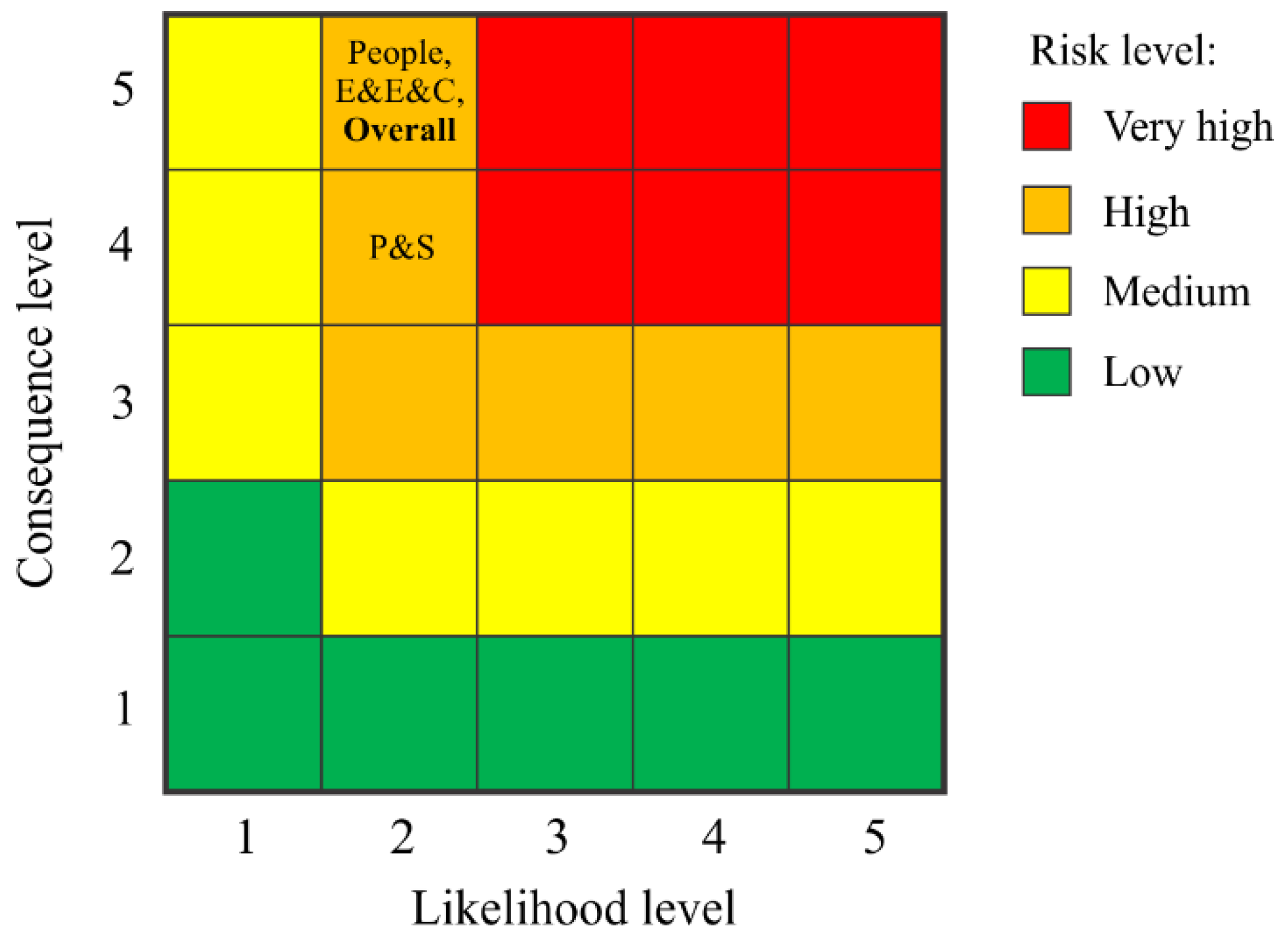
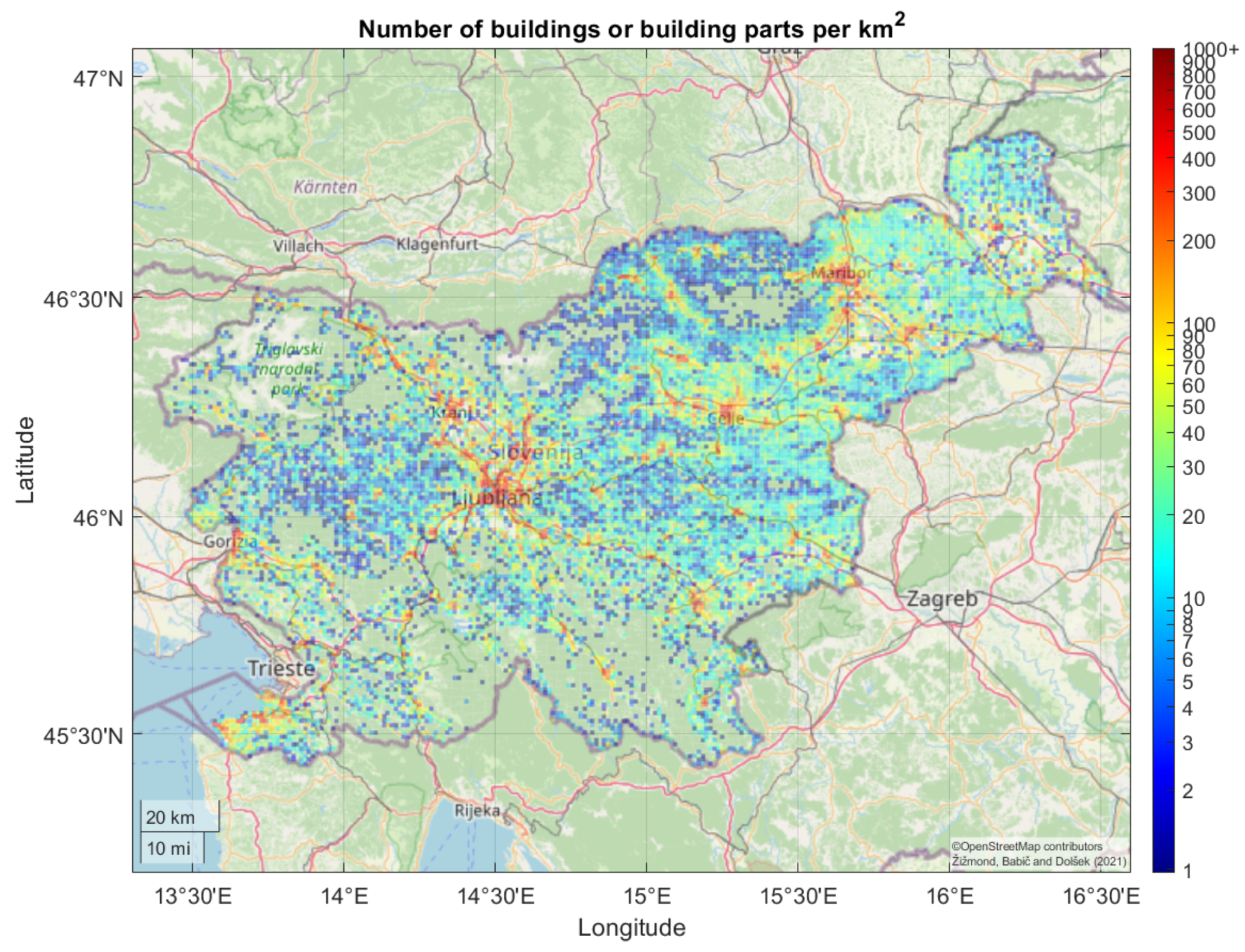
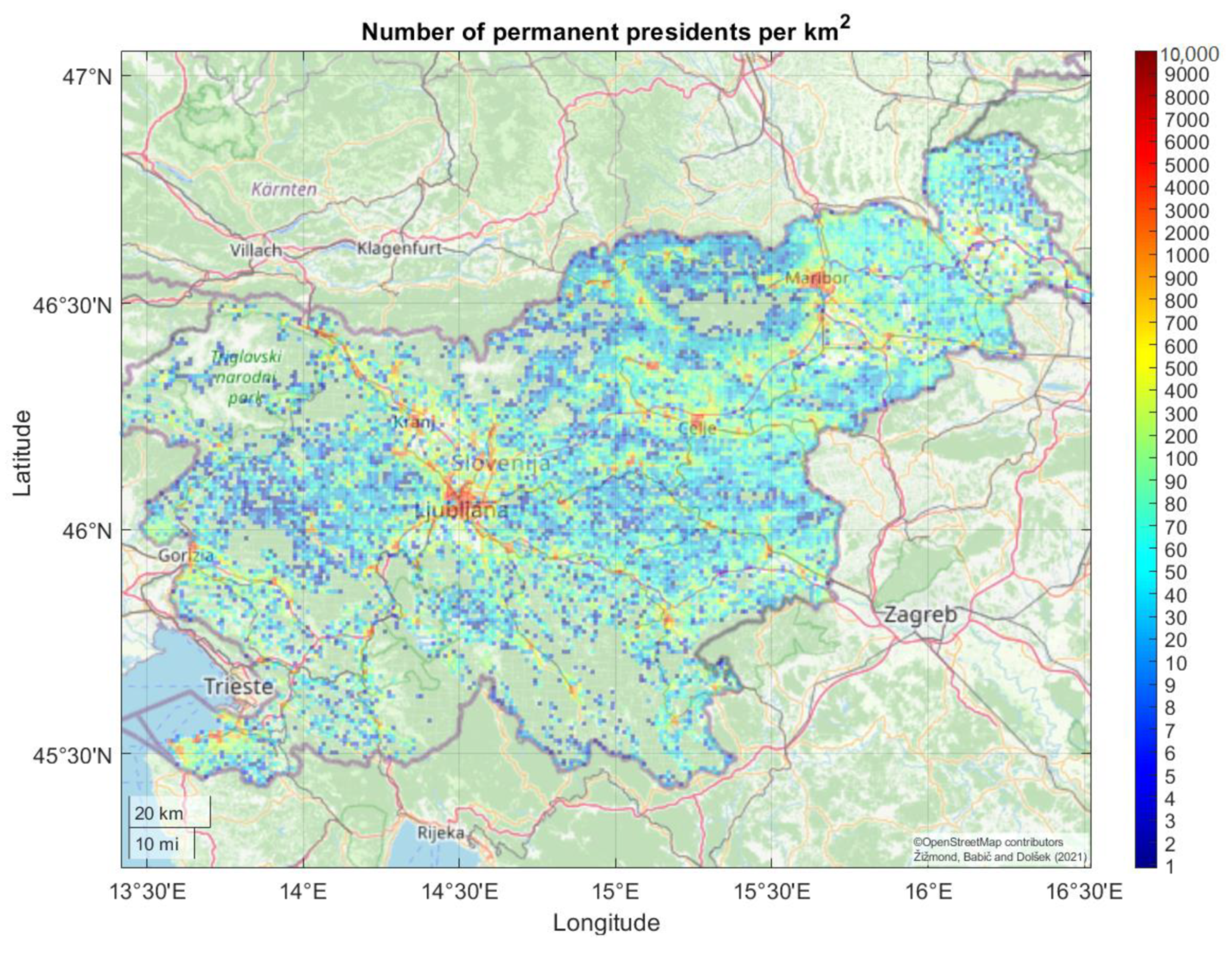
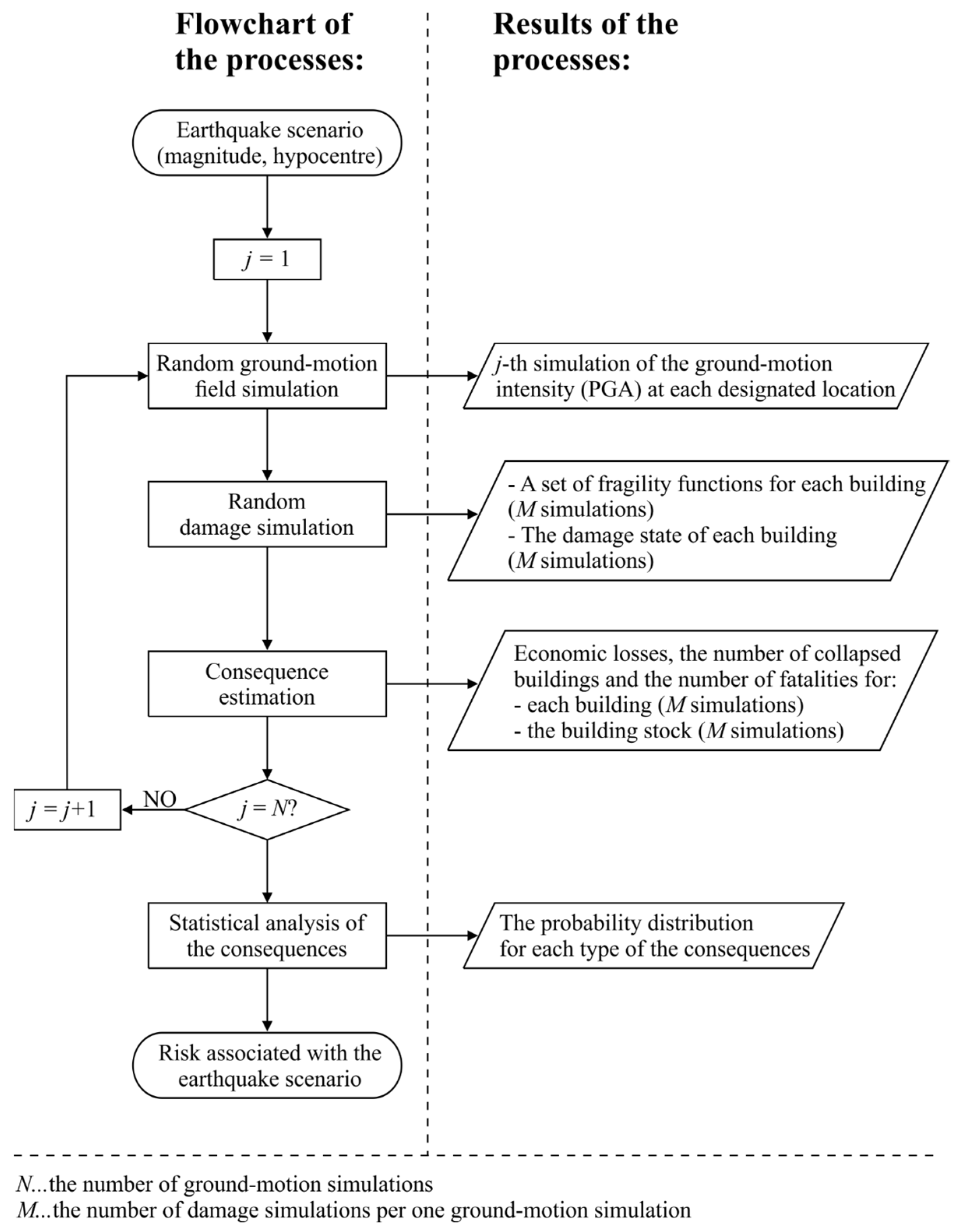
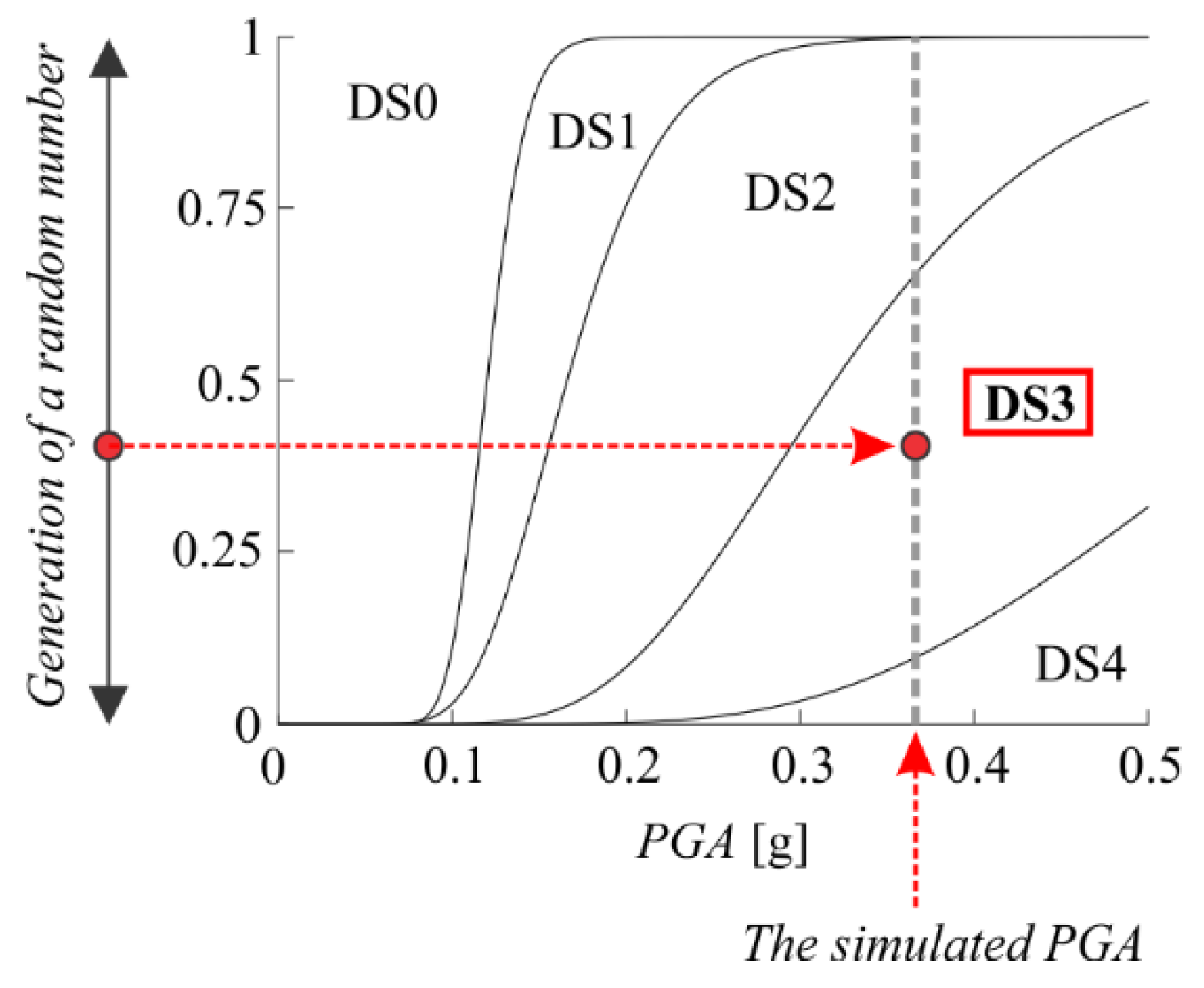

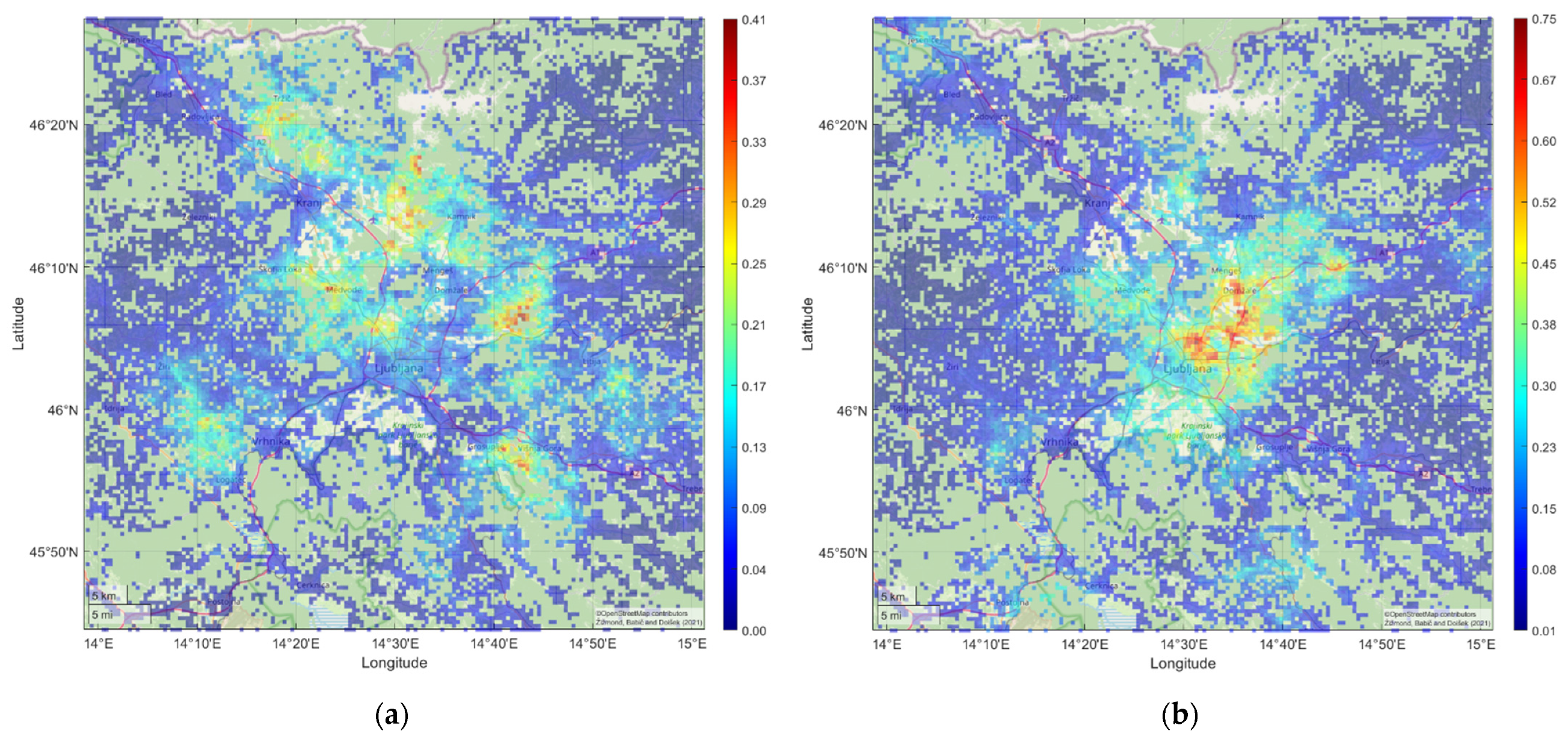

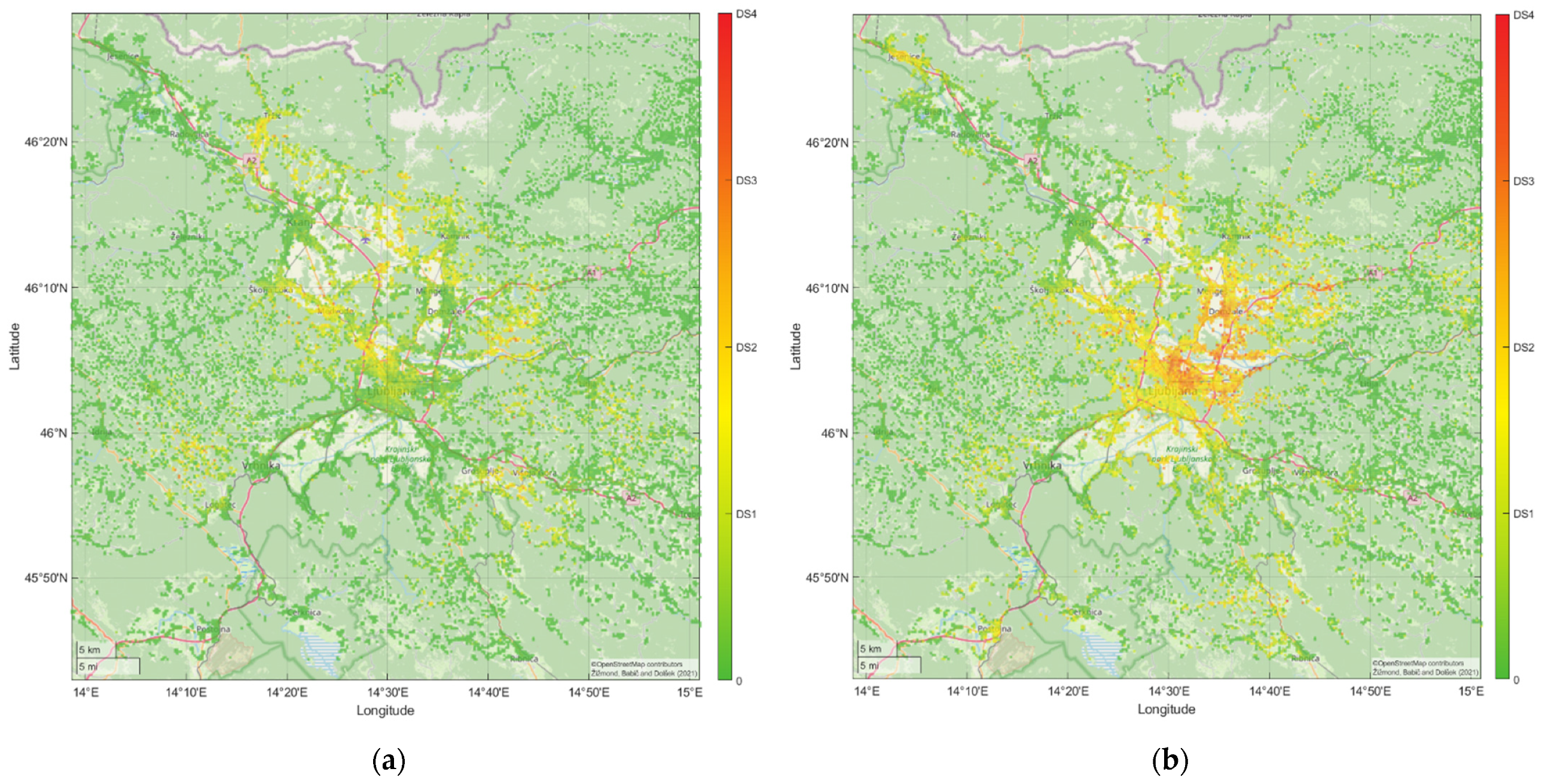
| Building Class | Load-Bearing Structure Material | Construction Period | Number of Storeys | Number of Buildings (×103) | Estimated Market Value (Billion EUR) | Number of Residents (×103) |
|---|---|---|---|---|---|---|
| 1 | Brick, stone (masonry) | Until 1964 | 1–3 | 109.1 | 10.076 | 342.7 |
| 2 | 4 or more | 4.7 | 3.748 | 72.5 | ||
| 3 | 1965–1981 | 1–3 | 95.9 | 10.098 | 328.5 | |
| 4 | 4 or more | 1.4 | 1.547 | 39.9 | ||
| 5 | From 1982 | 1–3 | 119.2 | 13.963 | 386.0 | |
| 6 | 4 or more | 1.3 | 1.427 | 26.8 | ||
| 7 | Reinforced concrete | Until 1964 | 1–3 | 4.9 | 1.208 | 13.5 |
| 8 | 4 or more | 0.7 | 1.4 | 18.3 | ||
| 9 | 1965–1981 | 1–3 | 13.9 | 3.596 | 41.1 | |
| 10 | 4–6 | 1.3 | 3.023 | 48.6 | ||
| 11 | 7 or more | 0.8 | 3.845 | 71.2 | ||
| 12 | From 1982 | 1–3 | 23.4 | 8.05 | 66.1 | |
| 13 | 4–6 | 1.8 | 5.525 | 52.6 | ||
| 14 | 7 or more | 0.5 | 3.506 | 37.1 | ||
| 15 | Unspecified, other | Until 1964 | 1–3 | 47.8 | 4.7 | 154.9 |
| 16 | 4 or more | 2.4 | 2.6 | 35.2 | ||
| 17 | 1965–1981 | 1–3 | 33.1 | 4.7 | 102.7 | |
| 18 | 4 or more | 1.1 | 2.5 | 40.6 | ||
| 19 | From 1982 | 1–3 | 56.3 | 10.2 | 146.0 | |
| 20 | 4 or more | 1.2 | 2.6 | 28.1 |
| 5th Percentile | 50th Percentile | 95th Percentile | |
|---|---|---|---|
| No. of buildings in DS1 | 16,949 | 22,957 | 30,187 |
| No. of buildings in DS2 | 17,129 | 34,367 | 47,818 |
| No. of buildings in DS3 | 2234 | 13,739 | 29,376 |
| No. of buildings in DS4 | 318 | 4681 | 24,210 |
| No. of collapsed buildings | 47 | 674 | 3487 |
| Expected no. of fatalities | 19 | 338 | 1820 |
| Direct economic losses (EUR) | 1.70 × 109 | 7.87 × 109 | 22.93 × 109 |
| 5th Percentile | 50th Percentile | 95th Percentile | |
|---|---|---|---|
| No. of buildings in DS1 | 24,254 | 25,192 | 26,294 |
| No. of buildings in DS2 | 32,423 | 35,666 | 39,502 |
| No. of buildings in DS3 | 8563 | 11,310 | 14,658 |
| No. of buildings in DS4 | 1749 | 2787 | 4390 |
| No. of collapsed buildings | 248 | 399 | 636 |
| Expected no. of fatalities | 142 | 241 | 391 |
| Direct economic losses (EUR) | 5.39 × 109 | 6.62 × 109 | 8.11 × 109 |
Publisher’s Note: MDPI stays neutral with regard to jurisdictional claims in published maps and institutional affiliations. |
© 2021 by the authors. Licensee MDPI, Basel, Switzerland. This article is an open access article distributed under the terms and conditions of the Creative Commons Attribution (CC BY) license (https://creativecommons.org/licenses/by/4.0/).
Share and Cite
Babič, A.; Dolšek, M.; Žižmond, J. Simulating Historical Earthquakes in Existing Cities for Fostering Design of Resilient and Sustainable Communities: The Ljubljana Case. Sustainability 2021, 13, 7624. https://doi.org/10.3390/su13147624
Babič A, Dolšek M, Žižmond J. Simulating Historical Earthquakes in Existing Cities for Fostering Design of Resilient and Sustainable Communities: The Ljubljana Case. Sustainability. 2021; 13(14):7624. https://doi.org/10.3390/su13147624
Chicago/Turabian StyleBabič, Anže, Matjaž Dolšek, and Jure Žižmond. 2021. "Simulating Historical Earthquakes in Existing Cities for Fostering Design of Resilient and Sustainable Communities: The Ljubljana Case" Sustainability 13, no. 14: 7624. https://doi.org/10.3390/su13147624
APA StyleBabič, A., Dolšek, M., & Žižmond, J. (2021). Simulating Historical Earthquakes in Existing Cities for Fostering Design of Resilient and Sustainable Communities: The Ljubljana Case. Sustainability, 13(14), 7624. https://doi.org/10.3390/su13147624






